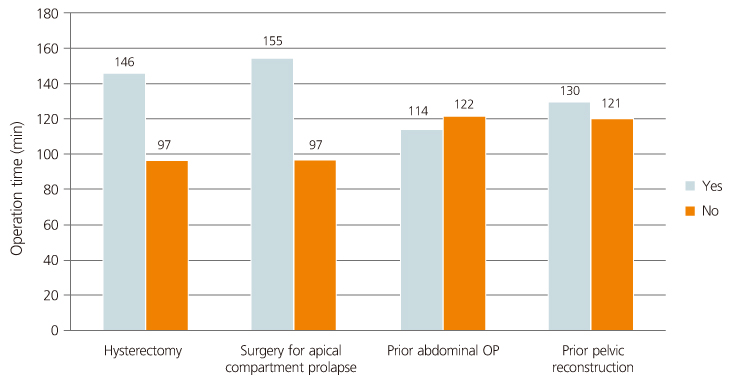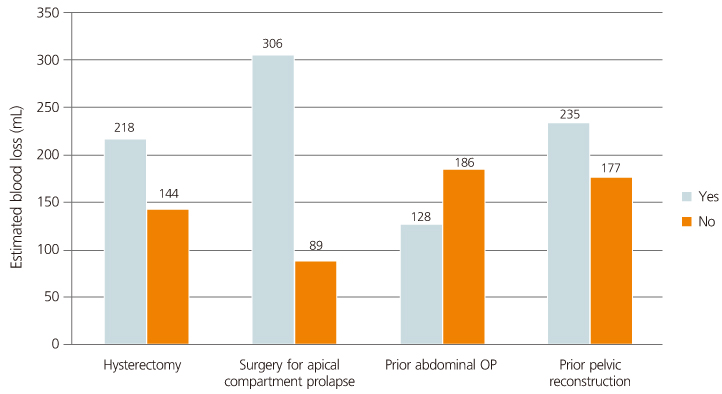Korean J Obstet Gynecol.
2012 Aug;55(8):564-572. 10.5468/KJOG.2012.55.8.564.
Comparison of perioperative, long-term complications and recurrence rates after vaginal prolapse surgery by considering ICS POP-Q stage
- Affiliations
-
- 1Department of Obstetrics and Gynecology, Institute of Women's Life Medical Science, Yonsei University College of Medicine, Seoul, Korea. swbai@yuhs.ac
- 2Department of Pharmacology, Yonsei University College of Medicine, Seoul, Korea.
- KMID: 2078106
- DOI: http://doi.org/10.5468/KJOG.2012.55.8.564
Abstract
OBJECTIVE
The aim of this study was to report subjective and objective outcomes and to compare complication and recurrence rate in patients undergoing surgery for International Continence Society (ICS) stage 4 prolapse compared to ICS stage 2 or 3 prolapse.
METHODS
We retrospectively reviewed the records of all patients having had surgical treatment for ICS Pelvic Organ Prolapse Quantification (POP-Q) stage 2-4 prolapse between January 2007 and December 2010 at the Yonsei University Severance Hospital. Only patients with ICS POP-Q stage 2-4 prolpase undergoing obliterative procedures or anti-incontinence surgery only were excluded.
RESULTS
Three hundred ninety nine patients met inclusion criteria, including 23 with stage 2, 239 with stage 3 and 137 with stage 4 prolapse. The postoperative recurrence rate of preoperative stage IV was 2.4 times higher than that of stage III. There was a significantly higher incidence rates of perioperative and long-term complications, compared to women with other stage prolapse. The mean operative time was significantly greater in the stage 4 group compared to the stage 2, 3 group.
CONCLUSION
The overall perioperative complication and recurrence rates in women undergoing surgery for pelvic organ prolapse are low. Women undergoing surgery for ICS POP-Q stage 4 prolapse were found to have a significantly greater blood loss and higher incidence rates of perioperative complications and recurrence, compared with women of other stage.
MeSH Terms
Figure
Reference
-
1. Holschneider CH, Berek JS. Berek JS, Novak E, editors. Valvar cancer. Berek & Novak's gynecology. 2007. 14th ed. Philadelphia (PA): Lippincott Williams & Wilkins;897–934.2. Olsen AL, Smith VJ, Bergstrom JO, Colling JC, Clark AL. Epidemiology of surgically managed pelvic organ prolapse and urinary incontinence. Obstet Gynecol. 1997. 89:501–506.3. Fialkow MF, Newton KM, Lentz GM, Weiss NS. Lifetime risk of surgical management for pelvic organ prolapse or urinary incontinence. Int Urogynecol J Pelvic Floor Dysfunct. 2008. 19:437–440.4. Smith FJ, Holman CD, Moorin RE, Tsokos N. Lifetime risk of undergoing surgery for pelvic organ prolapse. Obstet Gynecol. 2010. 116:1096–1100.5. Boyles SH, Weber AM, Meyn L. Procedures for urinary incontinence in the United States, 1979-1997. Am J Obstet Gynecol. 2003. 189:70–75.6. Luber KM, Boero S, Choe JY. The demographics of pelvic floor disorders: current observations and future projections. Am J Obstet Gynecol. 2001. 184:1496–1501.7. Dällenbach P, Jungo Nancoz C, Eperon I, Dubuisson JB, Boulvain M. Incidence and risk factors for reoperation of surgically treated pelvic organ prolapse. Int Urogynecol J. 2012. 23:35–41.8. Tegerstedt G, Hammarström M. Operation for pelvic organ prolapse: a follow-up study. Acta Obstet Gynecol Scand. 2004. 83:758–763.9. Whiteside JL, Weber AM, Meyn LA, Walters MD. Risk factors for prolapse recurrence after vaginal repair. Am J Obstet Gynecol. 2004. 191:1533–1538.10. Vakili B, Zheng YT, Loesch H, Echols KT, Franco N, Chesson RR. Levator contraction strength and genital hiatus as risk factors for recurrent pelvic organ prolapse. Am J Obstet Gynecol. 2005. 192:1592–1598.11. Nieminen K, Huhtala H, Heinonen PK. Anatomic and functional assessment and risk factors of recurrent prolapse after vaginal sacrospinous fixation. Acta Obstet Gynecol Scand. 2003. 82:471–478.12. Diez-Itza I, Aizpitarte I, Becerro A. Risk factors for the recurrence of pelvic organ prolapse after vaginal surgery: a review at 5 years after surgery. Int Urogynecol J Pelvic Floor Dysfunct. 2007. 18:1317–1324.13. Nam KH, Jeon MJ, Hur HW, Kim SK, Bai SW. Perioperative and long-term complications among obese women undergoing vaginal surgery. Int J Gynaecol Obstet. 2010. 108:244–246.14. Jeon MJ, Chung SM, Jung HJ, Kim SK, Bai SW. Risk factors for the recurrence of pelvic organ prolapse. Gynecol Obstet Invest. 2008. 66:268–273.15. Delancey JO, Hurd WW. Size of the urogenital hiatus in the levator ani muscles in normal women and women with pelvic organ prolapse. Obstet Gynecol. 1998. 91:364–368.16. Salvatore S, Athanasiou S, Digesu GA, Soligo M, Sotiropoulou M, Serati M, et al. Identification of risk factors for genital prolapse recurrence. Neurourol Urodyn. 2009. 28:301–304.17. Clark AL, Gregory T, Smith VJ, Edwards R. Epidemiologic evaluation of reoperation for surgically treated pelvic organ prolapse and urinary incontinence. Am J Obstet Gynecol. 2003. 189:1261–1267.18. Denman MA, Gregory WT, Boyles SH, Smith V, Edwards SR, Clark AL. Reoperation 10 years after surgically managed pelvic organ prolapse and urinary incontinence. Am J Obstet Gynecol. 2008. 198:555.e1–555.e5.19. Maher C, Baessler K, Glazener CM, Adams EJ, Hagen S. Surgical management of pelvic organ prolapse in women: a short version Cochrane review. Neurourol Urodyn. 2008. 27:3–12.20. Buchsbaum GM, Duecy EE, Kerr LA, Huang LS, Perevich M, Guzick DS. Pelvic organ prolapse in nulliparous women and their parous sisters. Obstet Gynecol. 2006. 108:1388–1393.21. Jack GS, Nikolova G, Vilain E, Raz S, Rodríguez LV. Familial transmission of genitovaginal prolapse. Int Urogynecol J Pelvic Floor Dysfunct. 2006. 17:498–501.22. Moalli PA, Shand SH, Zyczynski HM, Gordy SC, Meyn LA. Remodeling of vaginal connective tissue in patients with prolapse. Obstet Gynecol. 2005. 106:953–963.23. Norton PA, Baker JE, Sharp HC, Warenski JC. Genitourinary prolapse and joint hypermobility in women. Obstet Gynecol. 1995. 85:225–228.
- Full Text Links
- Actions
-
Cited
- CITED
-
- Close
- Share
- Similar articles
-
- Vaginal Approaches Using Synthetic Mesh to Treat Pelvic Organ Prolapse
- Outcomes of vaginal hysterectomy combined with anterior and posterior colporrhaphy for pelvic organ prolapse: a single center retrospective study
- A clinical study on the trocar-guided mesh repair system for pelvic organ prolapse surgery
- Efficacy and safety of uterosacral ligament vaginal vault suspension and levator myorrhaphy for pelvic organ prolapse
- Mid-term Results and Complications of Posterior Intravaginal Slingplasty for Patients with Uterine and Vaginal Vault Prolapse



